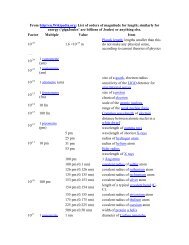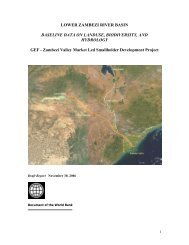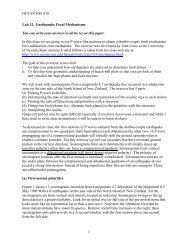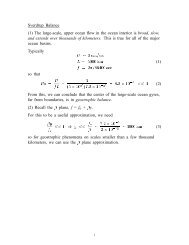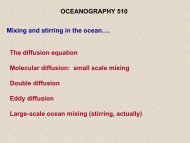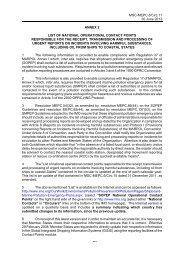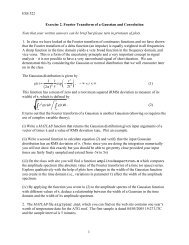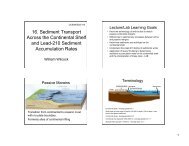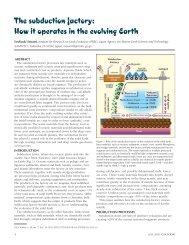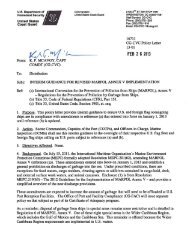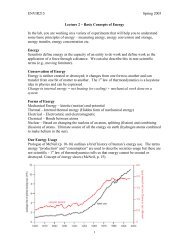2012 Seafloor Geodesy in Cascadia - William Wilcock - University of ...
2012 Seafloor Geodesy in Cascadia - William Wilcock - University of ...
2012 Seafloor Geodesy in Cascadia - William Wilcock - University of ...
You also want an ePaper? Increase the reach of your titles
YUMPU automatically turns print PDFs into web optimized ePapers that Google loves.
<strong>Seafloor</strong> <strong>Geodesy</strong> at Axial Seamount <br />
Bill Chadwick, Oregon State <strong>University</strong>/NOAA <br />
We have used pressure sensors to detect vertical displacements <strong>of</strong> the seafloor at Axial <br />
Seamount, an active submar<strong>in</strong>e volcano on the Juan de Fuca Ridge <strong>in</strong> the NE Pacific. <br />
Cont<strong>in</strong>uously record<strong>in</strong>g bottom pressure recorders (BPRs, similar to the DART tsunami <br />
detection systems operated by NOAA, but without the surface buoy for realtime <br />
communication) can detect sudden, short-‐term seafloor displacements that last seconds to <br />
days. At Axial, this <strong>in</strong>cludes signals from dike <strong>in</strong>trusions and deflation events dur<strong>in</strong>g <br />
<strong>in</strong>trusions or eruptions. In <strong>Cascadia</strong>, such short-‐term deformation signals might <strong>in</strong>clude co-seismic<br />
displacements on the overrid<strong>in</strong>g plate that are important for seismic source-model<strong>in</strong>g<br />
(like the results recently published from the 2011 Japan earthquake by Ito et al. <br />
[2011] <strong>in</strong> GRL). BPRs can be deployed as autonomous moor<strong>in</strong>gs for up to several years at a <br />
time, or can be connected to a cable (for example, on the planned OOI/RSN cabled <br />
observatory with a node at Axial Seamount). However, BPRs typically have long-‐term drift <br />
that can amount to up to 1 m/yr. <br />
To get around this problem and to measure gradual long-‐term volcanic <strong>in</strong>flation at Axial <br />
Seamount, we make ROV-‐based campaign-‐style pressure measurements at an array <strong>of</strong> <br />
seafloor benchmarks with a mobile pressure recorder (MPR). This method gives accurate <br />
relative depth measurements with a repeatability <strong>of</strong> about 1 cm/yr, but requires that there <br />
be a reference station that is assumed to be stable as part <strong>of</strong> the measurement array (which <br />
works well for focused volcano deformation, but would be more limit<strong>in</strong>g for try<strong>in</strong>g to <br />
measure regional deformation <strong>in</strong> <strong>Cascadia</strong>). At Axial, the MPR measurements are made <br />
every 1-‐3 years, dur<strong>in</strong>g one 2-‐3 day ROV dive, at an array <strong>of</strong> 6 benchmarks spann<strong>in</strong>g ~10 <br />
km, and have documented <strong>in</strong>flation rates <strong>of</strong> 5-‐15 cm/yr. At <strong>Cascadia</strong>, long-‐term gradual <br />
deformation signals <strong>of</strong> <strong>in</strong>terest would <strong>in</strong>clude <strong>in</strong>ter-‐seismic deformation <strong>of</strong> the cont<strong>in</strong>ental <br />
marg<strong>in</strong>, which would be important for model<strong>in</strong>g the extent <strong>of</strong> the locked zone. However, <br />
our MPR method would probably have to be modified for use <strong>in</strong> <strong>Cascadia</strong>, because <strong>of</strong> its <br />
limitations <strong>of</strong>: (1) only giv<strong>in</strong>g depth differences relative to a reference station, and (2) the <br />
limited distances that can be covered dur<strong>in</strong>g one ROV dive. For <strong>Cascadia</strong>, modified <br />
methods for long-‐term geodetic monitor<strong>in</strong>g might <strong>in</strong>clude: (1) MPR measurements at a <br />
more wide-‐spread array <strong>of</strong> benchmarks dur<strong>in</strong>g multiple ROV dives (this would relax the <br />
spatial restriction, but would <strong>in</strong>troduce more measurement error due to hysteresis), (2) <br />
use <strong>of</strong> absolute pressure sensors (for example, as developed by Mark Zumberge), or (3) <br />
GPS-‐acoustic rang<strong>in</strong>g (for example, as developed by Dave Chadwell). All <strong>of</strong> these <br />
alternatives would be more expensive than the methods we use at Axial Seamount. <br />
References: <br />
Chadwick, W. W., Jr., S. L. Nooner, D. A. Butterfield, and M. D. Lilley (<strong>2012</strong>), <strong>Seafloor</strong> <br />
deformation and forecasts <strong>of</strong> the April 2011 eruption at Axial Seamount, Nature <br />
Geosci., doi:10.1038/NGEO1464. <br />
Chadwick, W. W., Jr., S. Nooner, M. Zumberge, R. W. Embley, and C. G. Fox (2006), Vertical <br />
deformation monitor<strong>in</strong>g at Axial Seamount s<strong>in</strong>ce its 1998 eruption us<strong>in</strong>g deep-‐sea <br />
37



